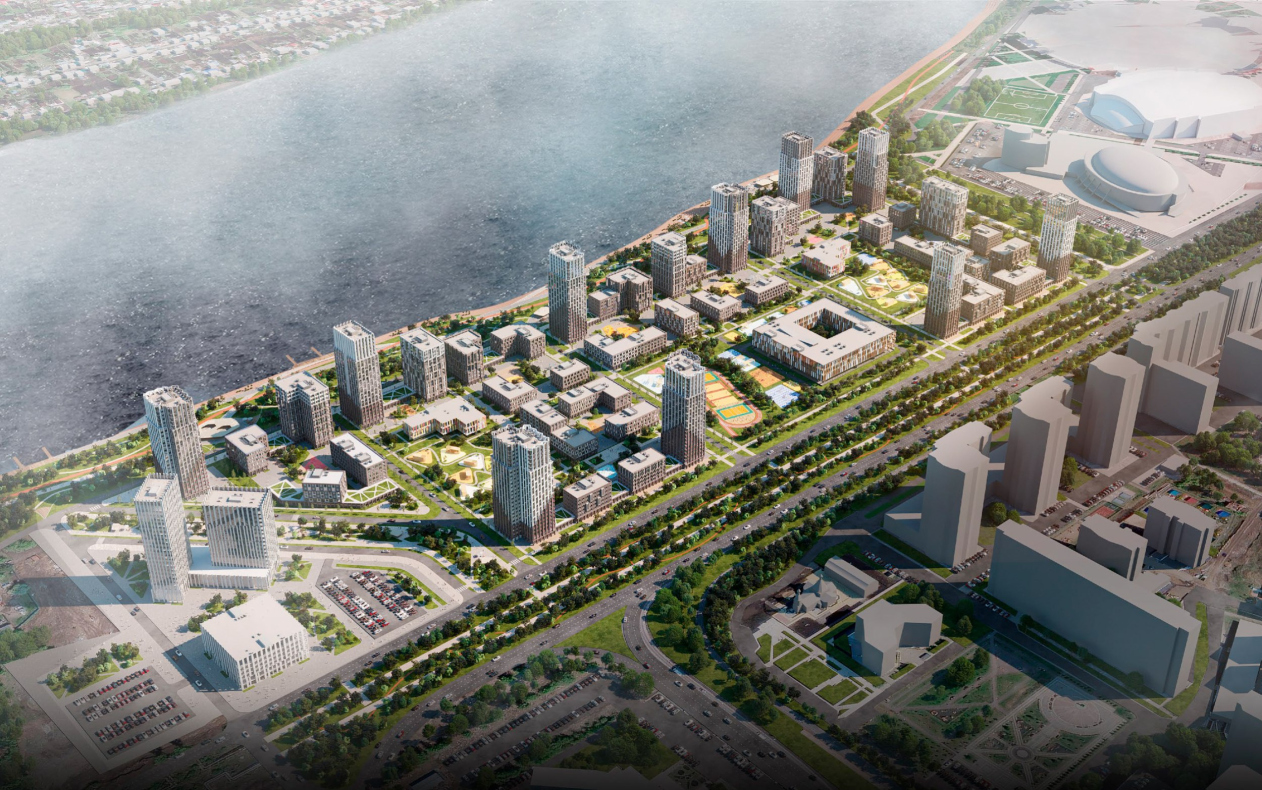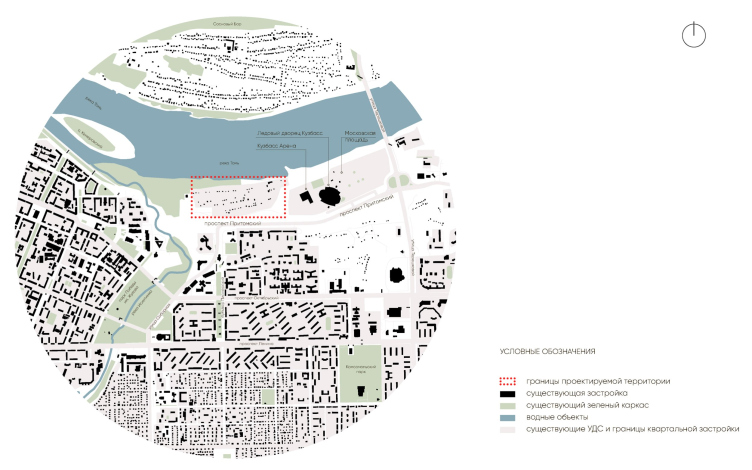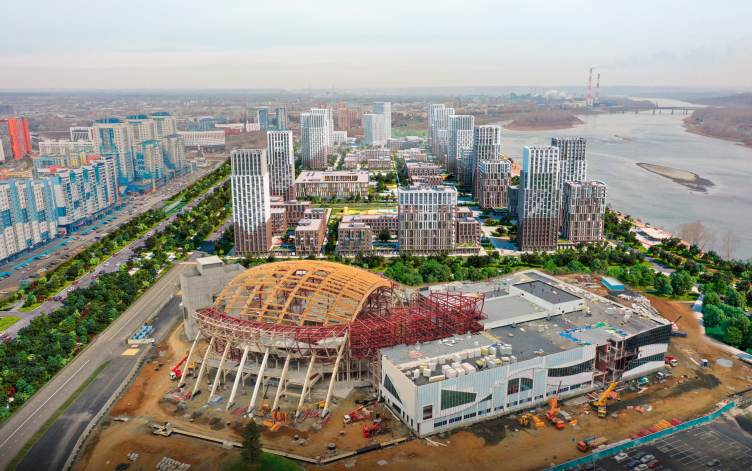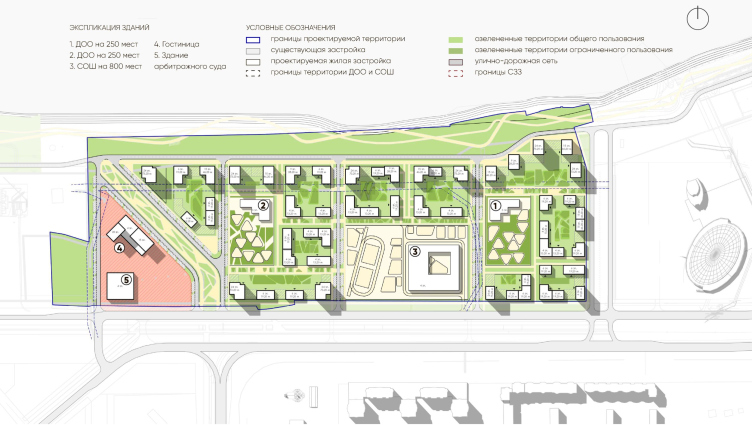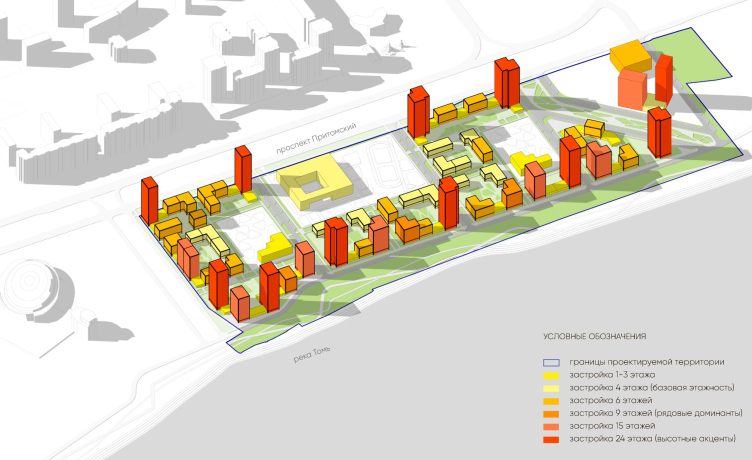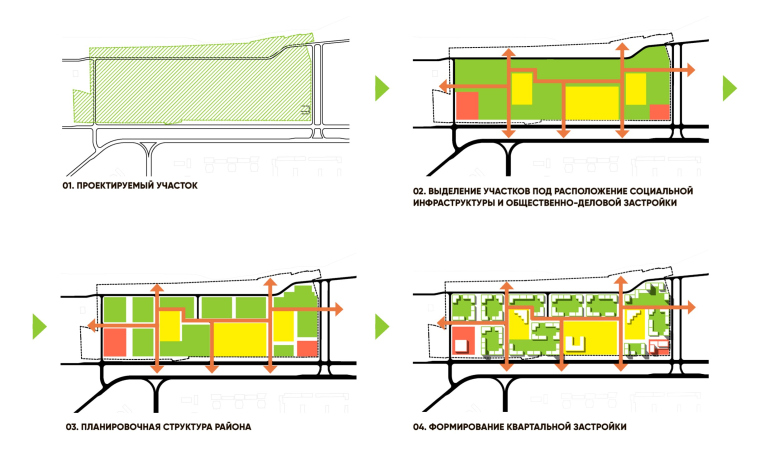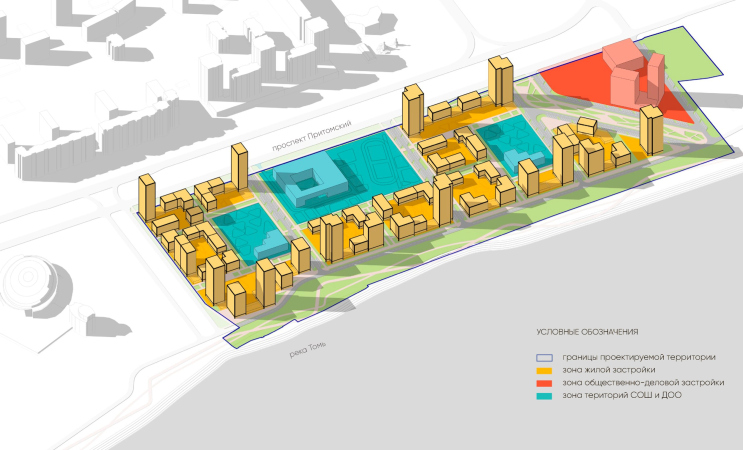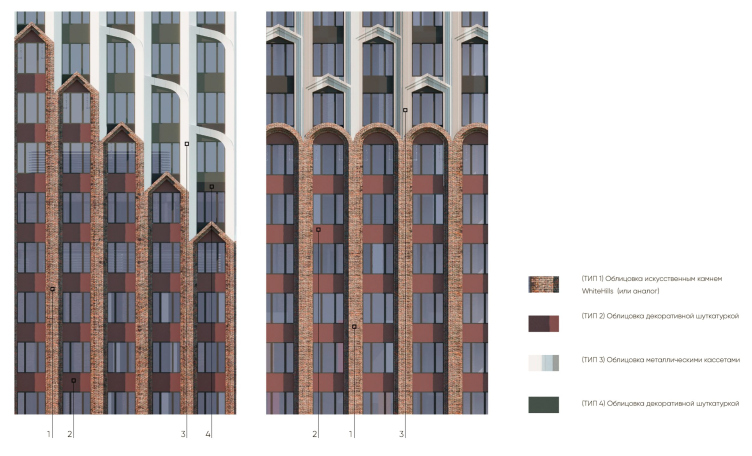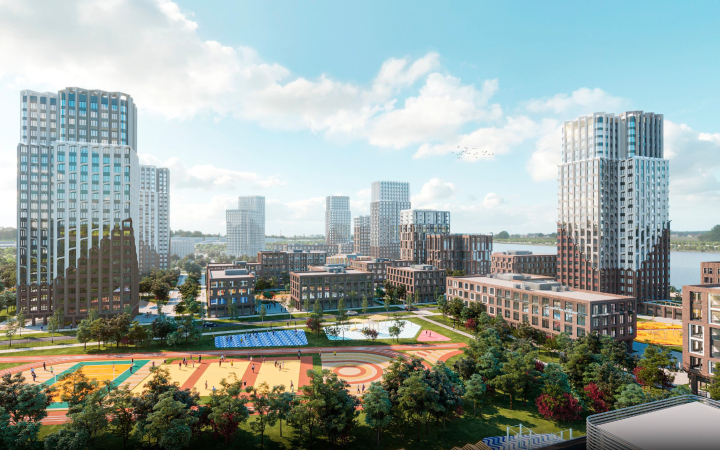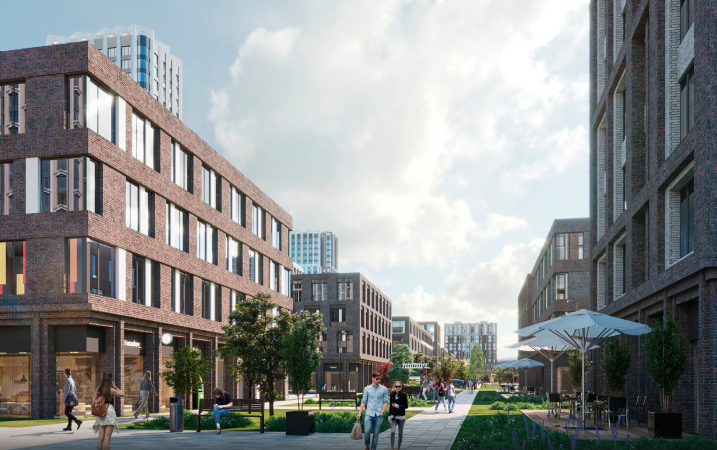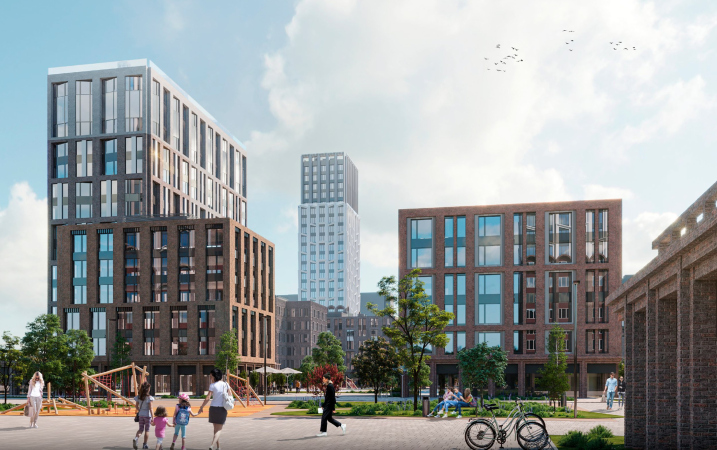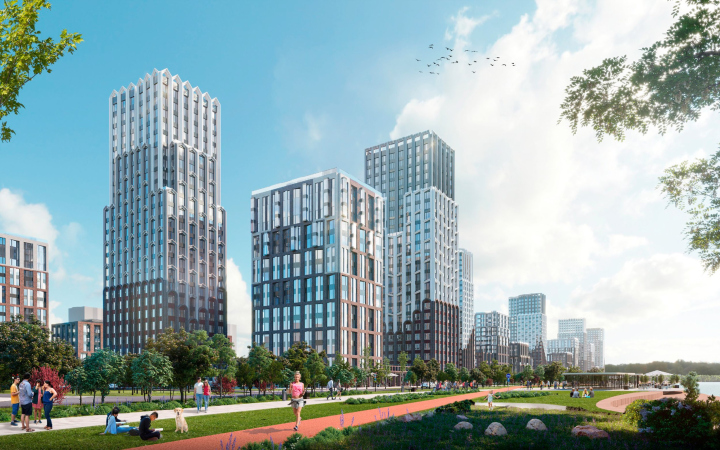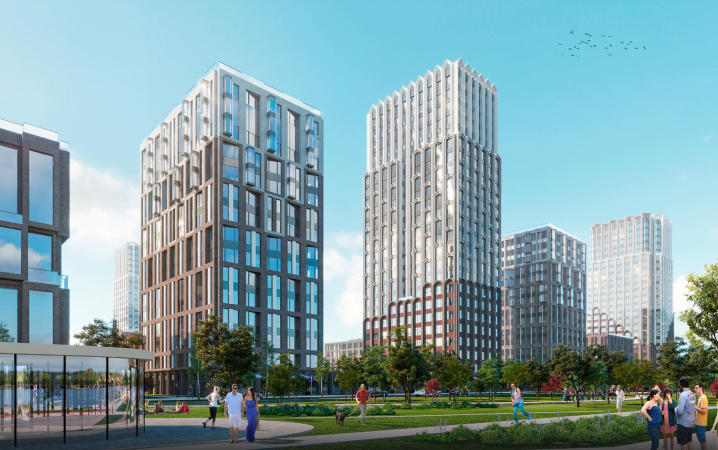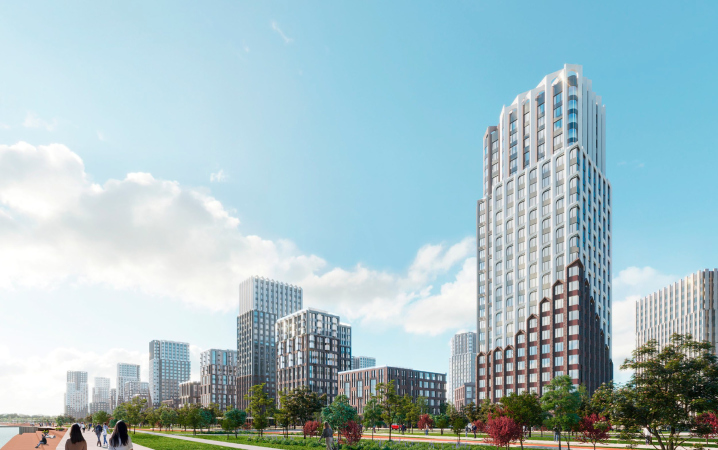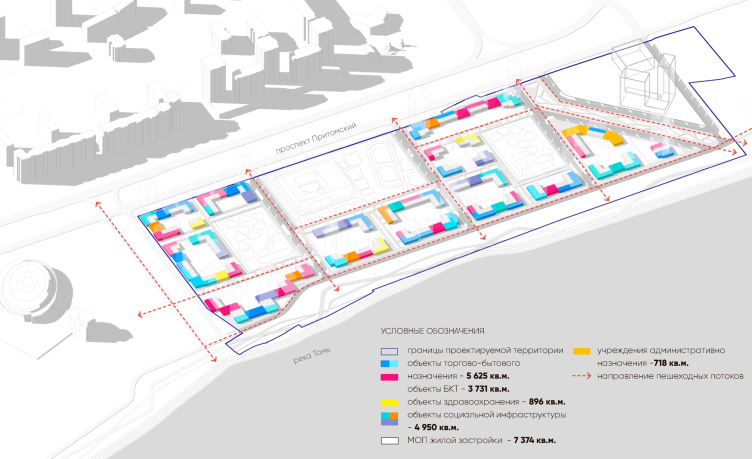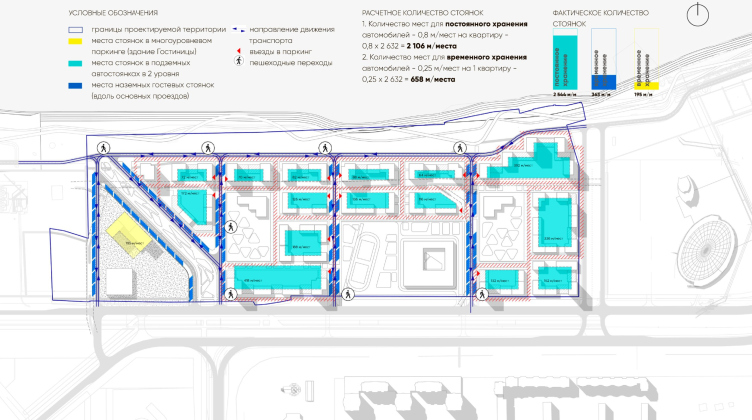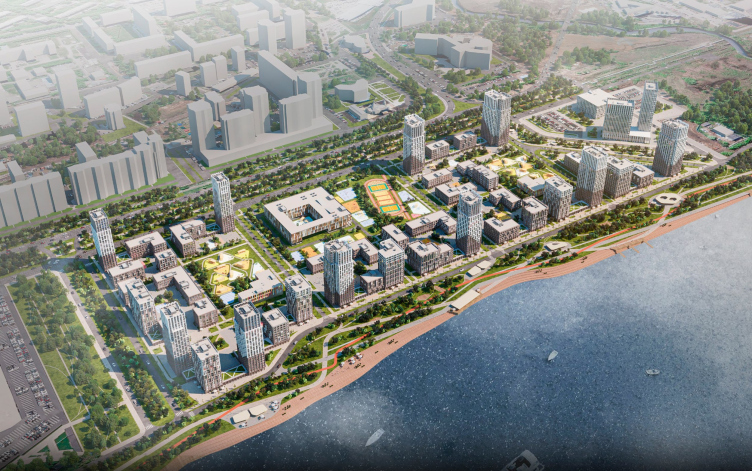In 2021, Kuzbass celebrated its 300th anniversary. By this date, Kemerovo, as the administrative center of the region, underwent significant transformations. Since 2019, a museum-theater center has been under construction here according to the Coop Himmelb(l)au project, and the accompanying educational campus designed by the “ARENA” Project Institute has already been completed. In 2021, the new terminal of the “Leonov” airport was opened, also designed by ASADOV Architects. The city’s 300th anniversary was not only used to build iconic projects; the approach to shaping the environment as a whole is also changing. For example, on the banks of the Tom River, where there were only wastelands and wooden houses not long ago, a new residential district is expected to emerge soon.
To the east of this area, the Ice Palace and the “Kuzbass-Arena” have already been built, becoming part of the Olympic Park with a promenade, pedestrian boulevard, skate park, summer theater, and a space for major urban events. Further, closer to the bridge and the intersection of Pritomsky Avenue, the “Moskovskaya Square” business district will appear with towers reaching up to 150 meters; it is currently being designed by the architectural company R1.
To the west, by the Iskitimka River, several projects are located, making this part of the city truly mixed-use: an administrative cluster, central station, philharmonic hall, justice quarter, and others. Against such an impressive background, the museum-and-theater complex will stand out, which is likely to become the main attraction in the city. In order for the functionally rich district to withstand the transportation load, the construction of a relief road of Pritomsky Avenue was completed in 2022.
To work on the concept of the last link – the modern residential complex that we are speaking about – the city authorities invited ASADOV Architects, asking them to bring metropolitan trends here.
At the opening of the Leonov Airport, I met the governor of the Kemerovo Region, Sergey Tsivilyov, and he suggested that we get involved in the project to develop the area near Pritomsky Avenue, which was already being developed by our local colleagues. Having studied their experience, as well as the peculiarities of the city, we formed neighborhoods and then maximized the number of stories. The contours are accentuated by towers reaching the maximum allowed height of 50 meters, the rest of the houses have several levels of height ranging from 4 to 15 floors. The bulk of the development faces the river, schools and kindergartens are located in the depths, and several accent towers “hold” the front of Pritomsky Avenue. We tried to both capture the spirit of the harsh Siberian expanses and contrast them with a modern structure.
Softening the Harsh Climate
The lyrical hero of Boris Grebenshchikov’s song, perhaps, was tempered by the long winter, rare sun, and scant colors of these parts:
The sky will collapse on the ground,
The grass will cease to grow —
He will come and silently fix everything,
The man from Kemerovo.
In reality, harsh climatic conditions are one of the main reasons people leave the city. And while industry becomes more environmentally friendly, the city as a whole develops, and the well-being of residents grows, the effects of global warming are not expected in Siberia any time soon.
The ASADOV Architects team attempted to make the climate of Kemerovo more comfortable using architectural means, at least within the confines of a given district. Therefore, the location and height of the sections directly depend on the analysis of wind flows and the movement of the sun.
The basis of the development consists of enclosed spaces of mid-rise residential blocks, while the “regulatory” towers prevent the formation of wind corridors. Additional protection in the future can be provided by artificial hills and landscape plantings. Schools and kindergartens are shielded by residential sections. Their location in the center of the district also provides a sense of spaciousness within the new blocks.
Another feature of Kemerovo that is important to mention is its seismic activity, caused not only by the movement of the Salair and Kuznetsky Alatau mountain systems but also by regular explosions at the local coal mines. After the Bachat earthquake in 2013, there was even a temporary ban on the construction of high-rise buildings in the city.
The task of making a convenient master plan and interesting facades was complicated by the need to take into account the wind pattern, harsh winters, and the district’s location on the first line from the river, as well as seismicity. The blocks are formed in such a way as to avoid wind corridors, to make the environment cozy, and from the apartments to reveal views of the river and the city. Taking into account the amount of precipitation, the volumes of the houses are laconic, with no protruding cantilevers or active plastique on the facades to avoid additional cold bridges. At the same time, the facades are more detailed at eye level: this makes the environment looks friendlier and more diverse. We also took into account the overall appearance of the buildings standing on the navigable Tomsk River side.
Accents, Landmarks, and Background
Monotony is one of the main problems of Kemerovo. To achieve a variety of perspectives and apartment layouts, as well as spatial impressions, the architects used three building typologies: accent towers, landmarks, and, finally, the background development.
The visual axes are anchored by accent buildings with a height of 24 floors: they are visible from afar, they have more active plasticity and developed decor – for example, arched windows, dentils, shifts in the window grid. Derived from the accents are the dominant towers, which stand out physically due to their height of 9-15 floors. Together with the dominant towers, they form a silhouette and become landmarks. Accents are shaded by background architecture of 4-6 floors – calm, but not monotonous, as it varies the combination of colors or plastic solutions.
All three building types form a rhythmic and varied environment without visual “noise”. We introduce only two colors: terracotta “grounds” the building and white dematerializes the volumes. The upper floors of high-rise buildings are characterized by the visual consolidation of windows. These techniques create a sense of lower storey height.
All three building types form a rhythmic and varied environment without visual “noise”. We introduce only two colors: terracotta “grounds” the building and white dematerializes the volumes. The upper floors of high-rise buildings are characterized by the visual consolidation of windows. These techniques create a sense of lower storey height.
No two houses here are identical; each has its own plastique or color technique. At the same time, they are united by a single design code and the “supergraphics” of the towers: the proposed brick cladding of the base and the tongs-like finish make it resemble a palisade of a fortress. This image refers to Kemerovo’s wooden past and the common image of a fortress-like house, which seems particularly appropriate here: what protects against the piercing wind and penetrating cold better than the sturdy walls of your sweet home?
The arch-like finials and white tongs reminiscent of New York’s stepped towers lead to other associations: corbel arches, gables, and the turrets of stone churches – all of these things have become quite trendy lately. However, the level of abstraction is such that, when viewed from another perspective, these elements can be interpreted as ice crystals, frost creeping on a frozen window, or perhaps snow whirls.
Snow Lovers Society
The goal of the proposed concept is to turn Kemerovo into a pleasant city year-round. To ensure that life does not freeze inside apartments, the architects have provided scenarios that will easily integrate into residents’ daily lives and diversify or make daily routines more comfortable.
The ground floors of the buildings standing along the outer contour are entirely dedicated to commerce: this will expand career opportunities for young people, and the residents will have the necessary services available at their doorstep. Events and related businesses can also add to the overall activity: holidays, fairs, and seasonal festivals, which are unthinkable without pavilions for cafes and sports equipment rental.
The waterfront could become the main leisure area. The concept offers a possible development option: with pedestrian and bicycle paths that turn into ski tracks in winter, slopes leading down to the river, swimming and sunbathing areas, fishing piers, boat docks, and various pavilions. On the opposite bank of the Tom River is the Pine Forest Park, considered the city’s “lungs” and a place for active recreation. This park could be connected to the new “micro-district” with pedestrian bridges.
Without a doubt, apartments with a view of the river in the city center will be in high demand. It’s quite good news that this new district can become not just a collection of square meters but an example of a livable environment – with wind-sheltered courtyards, cozy and bustling streets, clear navigation, sweeping views from the windows, and various reasons to leave one’s home and go outside as well.

